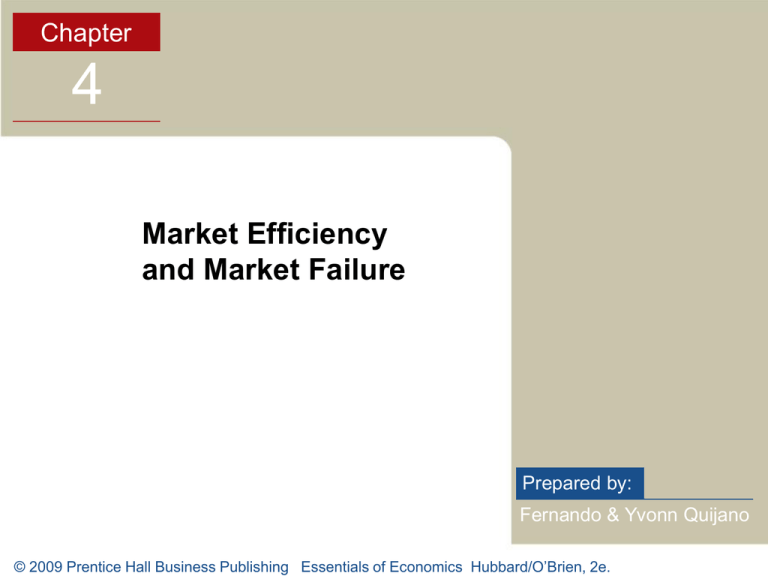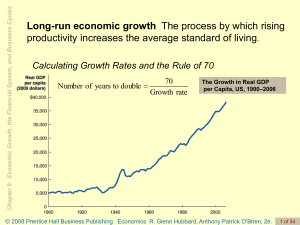4 Market Efficiency and Market Failure Chapter
advertisement

Chapter 4 Market Efficiency and Market Failure Prepared by: Fernando & Yvonn Quijano © 2009 Prentice Hall Business Publishing Essentials of Economics Hubbard/O’Brien, 2e. Market Efficiency and Market Failure Chapter 4: Economic Efficiency, Government Price Setting, and Taxes Price ceiling A legally determined maximum price that sellers may charge. Price floor A legally determined minimum price that sellers may receive. Externality A benefit or cost that affects someone who is not directly involved in the production or consumption of a good or service. © 2009 Prentice Hall Business Publishing Economics R. Glenn Hubbard, Anthony Patrick O’Brien, 2e. 2 of 35 Learning Objective 4.1 Consumer Surplus and Producer Surplus 4.1 Chapter 4: Economic Efficiency, Government Price Setting, and Taxes Consumer Surplus Consumer surplus The difference between the highest price a consumer is willing to pay and the price the consumer actually pays. Marginal benefit The additional benefit to a consumer from consuming one more unit of a good or service. © 2009 Prentice Hall Business Publishing Economics R. Glenn Hubbard, Anthony Patrick O’Brien, 2e. 3 of 35 Learning Objective 4.1 Consumer Surplus and Producer Surplus Consumer Surplus FIGURE 4-3 Chapter 4: Economic Efficiency, Government Price Setting, and Taxes Total Consumer Surplus in the Market for Chai Tea © 2009 Prentice Hall Business Publishing Economics R. Glenn Hubbard, Anthony Patrick O’Brien, 2e. 4 of 35 Learning Objective 4.1 Chapter 4: Economic Efficiency, Government Price Setting, and Taxes Making The Consumer Surplus from the Satellite Television Connection Consumer surplus allows us to measure the benefit consumers receive in excess of the price they paid to purchase a product. © 2009 Prentice Hall Business Publishing Economics R. Glenn Hubbard, Anthony Patrick O’Brien, 2e. 5 of 35 Learning Objective 4.1 Consumer Surplus and Producer Surplus Producer Surplus Chapter 4: Economic Efficiency, Government Price Setting, and Taxes Marginal cost The additional cost to a firm of producing one more unit of a good or service. Producer surplus The difference between the lowest price a firm would have been willing to accept and the price it actually receives. © 2009 Prentice Hall Business Publishing Economics R. Glenn Hubbard, Anthony Patrick O’Brien, 2e. 6 of 35 Learning Objective 4.1 Consumer Surplus and Producer Surplus Producer Surplus FIGURE 4-4 Chapter 4: Economic Efficiency, Government Price Setting, and Taxes Calculating Producer Surplus © 2009 Prentice Hall Business Publishing Economics R. Glenn Hubbard, Anthony Patrick O’Brien, 2e. 7 of 35 Learning Objective 4.1 Consumer Surplus and Producer Surplus Chapter 4: Economic Efficiency, Government Price Setting, and Taxes What Consumer Surplus and Producer Surplus Measure Consumer surplus measures the net benefit to consumers from participating in a market rather than the total benefit. The net benefit equals the total benefit received by consumers minus the total amount they must pay to buy the good. Similarly, producer surplus measures the net benefit received by producers from participating in a market, or the total amount firms receive from consumers minus the cost of producing the good. © 2009 Prentice Hall Business Publishing Economics R. Glenn Hubbard, Anthony Patrick O’Brien, 2e. 8 of 35 Learning Objective 4.2 The Efficiency of Competitive Markets Marginal Benefit Equals Marginal Cost in Competitive Equilibrium FIGURE 4-5 Chapter 4: Economic Efficiency, Government Price Setting, and Taxes Marginal Benefit Equals Marginal Cost Only at Competitive Equilibrium © 2009 Prentice Hall Business Publishing Economics R. Glenn Hubbard, Anthony Patrick O’Brien, 2e. 9 of 35 Learning Objective 4.2 The Efficiency of Competitive Markets Economic Surplus Economic surplus The sum of consumer surplus and producer surplus. Chapter 4: Economic Efficiency, Government Price Setting, and Taxes FIGURE 4-6 Economic Surplus Equals the Sum of Consumer Surplus and Producer Surplus © 2009 Prentice Hall Business Publishing Economics R. Glenn Hubbard, Anthony Patrick O’Brien, 2e. 10 of 35 Learning Objective 4.2 The Efficiency of Competitive Markets Deadweight Loss FIGURE 4-7 Chapter 4: Economic Efficiency, Government Price Setting, and Taxes When a Market Is Not in Equilibrium There is a Deadweight Loss Deadweight loss The reduction in economic surplus resulting from a market not being in competitive equilibrium. © 2009 Prentice Hall Business Publishing Economics R. Glenn Hubbard, Anthony Patrick O’Brien, 2e. 11 of 35 Learning Objective 4.2 The Efficiency of Competitive Markets Chapter 4: Economic Efficiency, Government Price Setting, and Taxes Economic Surplus and Economic Efficiency Economic efficiency A market outcome in which the marginal benefit to consumers of the last unit produced is equal to its marginal cost of production, and in which the sum of consumer surplus and producer surplus is at a maximum. © 2009 Prentice Hall Business Publishing Economics R. Glenn Hubbard, Anthony Patrick O’Brien, 2e. 12 of 35 Learning Objective 4.3 Government Intervention in the Market: Price Floors And Price Ceilings Price Floors: Government Policy in Agricultural Markets Chapter 4: Economic Efficiency, Government Price Setting, and Taxes FIGURE 4-8 The Economic Effect of a Price Floor in the Wheat Market © 2009 Prentice Hall Business Publishing Economics R. Glenn Hubbard, Anthony Patrick O’Brien, 2e. 13 of 35 Learning Objective 4.3 Chapter 4: Economic Efficiency, Government Price Setting, and Taxes Making Price Floors in Labor Markets: The the Debate Over Minimum Wage Policy Connection © 2009 Prentice Hall Business Publishing Economics R. Glenn Hubbard, Anthony Patrick O’Brien, 2e. 14 of 35 Learning Objective 4.3 Government Intervention in the Market: Price Floors And Price Ceilings Price Ceilings: Government Rent Control Policy in Housing Markets Chapter 4: Economic Efficiency, Government Price Setting, and Taxes FIGURE 4-9 The Economic Effect of a Rent Ceiling Don’t Let This Happen to YOU! Don’t Confuse “Scarcity” with a “Shortage” © 2009 Prentice Hall Business Publishing Economics R. Glenn Hubbard, Anthony Patrick O’Brien, 2e. 15 of 35 Learning Objective 4.3 Government Intervention in the Market: Price Floors And Price Ceilings Chapter 4: Economic Efficiency, Government Price Setting, and Taxes Black Markets Black markets A market in which buying and selling take place at prices that violate government price regulations. © 2009 Prentice Hall Business Publishing Economics R. Glenn Hubbard, Anthony Patrick O’Brien, 2e. 16 of 35 Learning Objective 4.3 Solved Problem 4-3 Chapter 4: Economic Efficiency, Government Price Setting, and Taxes What’s the Economic Effect of a “Black Market” for Apartments? © 2009 Prentice Hall Business Publishing Economics R. Glenn Hubbard, Anthony Patrick O’Brien, 2e. 17 of 35 Learning Objective 4.3 Government Intervention in the Market: Price Floors And Price Ceilings The Results of Government Price Controls: Winners, Losers, and Inefficiency Chapter 4: Economic Efficiency, Government Price Setting, and Taxes When the government imposes price floors or price ceilings, three important results occur: • Some people win. • Some people lose. • There is a loss of economic efficiency. © 2009 Prentice Hall Business Publishing Economics R. Glenn Hubbard, Anthony Patrick O’Brien, 2e. 18 of 35 Learning Objective 4.3 Government Intervention in the Market: Price Floors And Price Ceilings Chapter 4: Economic Efficiency, Government Price Setting, and Taxes Positive and Normative Analysis of Price Ceilings and Price Floors Whether rent controls or federal farm programs are desirable or undesirable is a normative question. Whether the gains to the winners more than make up for the losses to the losers and for the decline in economic efficiency is a matter of judgment and not strictly an economic question. © 2009 Prentice Hall Business Publishing Economics R. Glenn Hubbard, Anthony Patrick O’Brien, 2e. 19 of 35 Learning Objective 4.4 Externalities and Economic Efficiency The Effect of Externalities Chapter 4: Economic Efficiency, Government Price Setting, and Taxes Private cost The cost borne by the producer of a good or service. Social cost The total cost of producing a good, including both the private cost and any external cost. Private benefit The benefit received by the consumer of a good or service. Social benefit The total benefit from consuming a good or service, including both the private benefit and any external benefit. © 2009 Prentice Hall Business Publishing Economics R. Glenn Hubbard, Anthony Patrick O’Brien, 2e. 20 of 35 Learning Objective 4.4 Externalities and Economic Efficiency The Effect of Externalities How a Negative Externality in Production Reduces Economic Efficiency Chapter 4: Economic Efficiency, Government Price Setting, and Taxes FIGURE 4-10 The Effect of Pollution on Economic Efficiency © 2009 Prentice Hall Business Publishing Economics R. Glenn Hubbard, Anthony Patrick O’Brien, 2e. 21 of 35 Learning Objective 4.4 Externalities and Economic Efficiency The Effect of Externalities How a Positive Externality in Consumption Reduces Economic Efficiency Chapter 4: Economic Efficiency, Government Price Setting, and Taxes FIGURE 4-11 The Effect of a Positive Externality on Efficiency © 2009 Prentice Hall Business Publishing Economics R. Glenn Hubbard, Anthony Patrick O’Brien, 2e. 22 of 35 Learning Objective 4.4 Externalities and Economic Efficiency Externalities May Result in Market Failure Chapter 4: Economic Efficiency, Government Price Setting, and Taxes Market failure A situation in which the market fails to produce the efficient level of output. What Causes Externalities? Property rights The rights individuals or businesses have to the exclusive use of their property, including the right to buy or sell it. © 2009 Prentice Hall Business Publishing Economics R. Glenn Hubbard, Anthony Patrick O’Brien, 2e. 23 of 35 Learning Objective 4.5 Government Policies to Deal with Externalities Chapter 4: Economic Efficiency, Government Price Setting, and Taxes FIGURE 4.12 When There Is a Negative Externality, a Tax Can Bring about the Efficient Level of Output © 2009 Prentice Hall Business Publishing Economics R. Glenn Hubbard, Anthony Patrick O’Brien, 2e. 24 of 35 Learning Objective 4.5 Solved Problem 4-5 Chapter 4: Economic Efficiency, Government Price Setting, and Taxes Using a Tax to Deal with a Negative Externality © 2009 Prentice Hall Business Publishing Economics R. Glenn Hubbard, Anthony Patrick O’Brien, 2e. 25 of 35 Learning Objective 4.5 Government Policies to Deal with Externalities FIGURE 4-13 Chapter 4: Economic Efficiency, Government Price Setting, and Taxes When There Is a Positive Externality, a Subsidy Can Bring about the Efficient Level of Output © 2009 Prentice Hall Business Publishing Economics R. Glenn Hubbard, Anthony Patrick O’Brien, 2e. 26 of 35 Learning Objective 4.5 Government Policies to Deal with Externalities Chapter 4: Economic Efficiency, Government Price Setting, and Taxes Pigovian taxes and subsidies Government taxes and subsidies intended to bring about an efficient level of output in the presence of externalities. Command and Control versus Tradable Emissions Allowances Command and control approach An approach that involves the government imposing quantitative limits on the amount of pollution firms are allowed to emit or requiring firms to install specific pollution control devices. © 2009 Prentice Hall Business Publishing Economics R. Glenn Hubbard, Anthony Patrick O’Brien, 2e. 27 of 35




